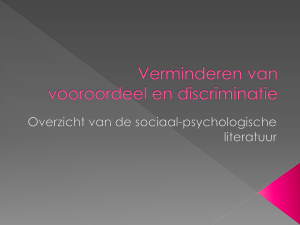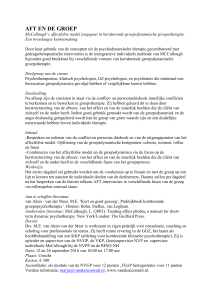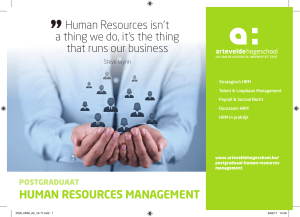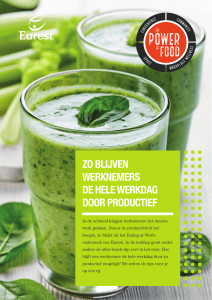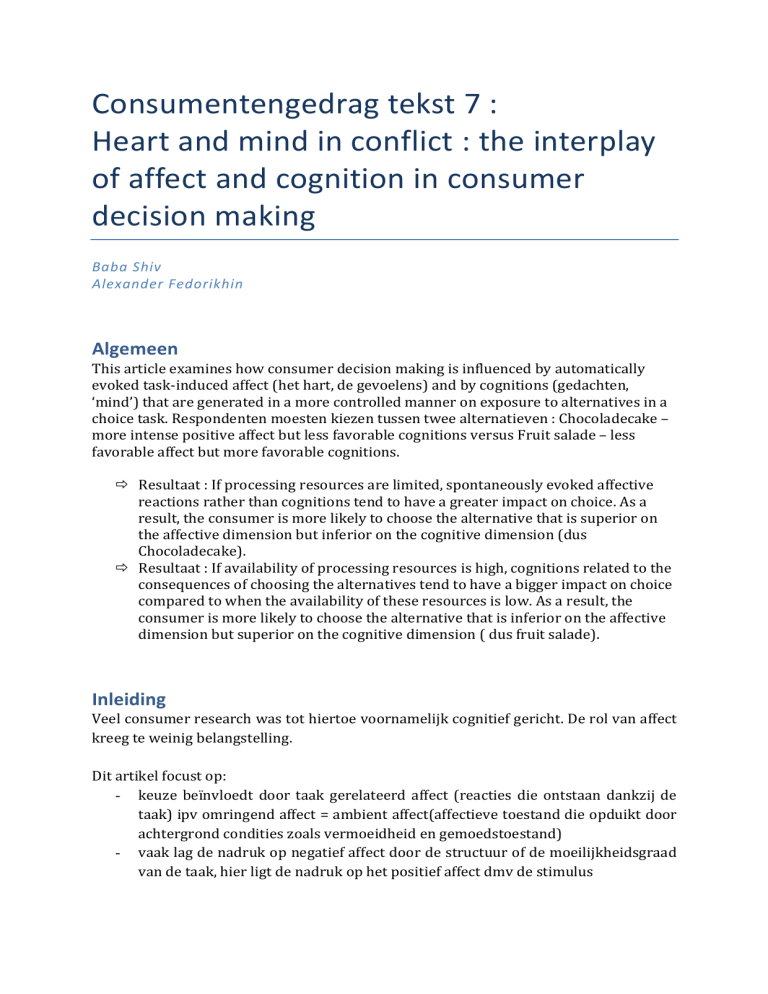
Consumentengedrag tekst 7 : Heart and mind in conflict : the interplay of affect and cognition in consumer decision making Baba Shiv Alexander Fedorikhin Algemeen This article examines how consumer decision making is influenced by automatically evoked task-­‐induced affect (het hart, de gevoelens) and by cognitions (gedachten, ‘mind’) that are generated in a more controlled manner on exposure to alternatives in a choice task. Respondenten moesten kiezen tussen twee alternatieven : Chocoladecake – more intense positive affect but less favorable cognitions versus Fruit salade – less favorable affect but more favorable cognitions. ð Resultaat : If processing resources are limited, spontaneously evoked affective reactions rather than cognitions tend to have a greater impact on choice. As a result, the consumer is more likely to choose the alternative that is superior on the affective dimension but inferior on the cognitive dimension (dus Chocoladecake). ð Resultaat : If availability of processing resources is high, cognitions related to the consequences of choosing the alternatives tend to have a bigger impact on choice compared to when the availability of these resources is low. As a result, the consumer is more likely to choose the alternative that is inferior on the affective dimension but superior on the cognitive dimension ( dus fruit salade). Inleiding Veel consumer research was tot hiertoe voornamelijk cognitief gericht. De rol van affect kreeg te weinig belangstelling. Dit artikel focust op: - keuze beïnvloedt door taak gerelateerd affect (reacties die ontstaan dankzij de taak) ipv omringend affect = ambient affect(affectieve toestand die opduikt door achtergrond condities zoals vermoeidheid en gemoedstoestand) - vaak lag de nadruk op negatief affect door de structuur of de moeilijkheidsgraad van de taak, hier ligt de nadruk op het positief affect dmv de stimulus -
lower-­‐order affectieve reacties: afkomstig van relatief automatische processen, door een alternatief in de keuze taak op gang gebracht : Dus : Our model proposes that, on exposure to alternatives in a choice task, tow types of processes may be engendered, one affective in nature and the other cognitive in nature. • The former process is likely to occur in a relatively automatic manner (i.e. less likely tob e affected by the availability of processing resources), resulting in the affective reactions that could differ on two dimensions, valence (positive or negative) and intensitiy. • The second type of process is liekly to occur in a relatively more controlled fashion (i.e. more likely tob e affected by the availability of processing resources), resulting in cognitions about the consequences of choosing the alternatives. Verder verwachten we dat – als de availability of processing resources beperkt is -­‐ the consument een beslissing neemt gebaseerd op het eerste : relatively automatic process (heart) = based on affect rather than on cognitions evoked by the alternatives – als de processing resources niet beperkt zijn -­‐ het tweede proces, relatively controlled process is liely to play a more important role, and hence, cognitions are likely to have a bigger impact on chocie than when these resources are constrained. Daarnaast bekijken we de modererende invloed van de presentatiewijze en de persoonlijke kenmerken van de consument. Theoretisch kader Theories involving the interaction between affect and cognition Berkowitz (1993): hoe affect en cognitie op elkaar inwerken en het gedrag beïnvloeden Drie types processen door blootstelling aan een stimulus: 1. relatieve basic en automatisch associative processen (lower-­‐order affective reactions) bv angst : eerste reactie 2. meer overleggend higher-­‐order cognitieve processing, kunnen de bovenvermelde lower-­‐order affectieve reacties afzwakken of versterken bv angst : denken aan de sociale regels dus niet luid schreeuwen 3. higher-­‐order affective reactions and action tendencies, relatief traag tov lower-­‐order affective reactions, more deliberative processes before these reactions can occur Affective-­‐cognitive model of consumer decision making à DUS twee processen bij blootstelling aan een alternatief in een keuzetaak: 1. gebeurt relatief automatisch en laat affectieve reacties toe die variëren in: aangeboren reactie a. waarde (positief of negatief) b. intensiteit 2. gebeurt meer overleggend en gecontroleerd en veroorzaken waarschijnlijk kennis over de alternatieven : a. kunnen zowel op stimulus als op geheugen gebaseerd zijn b. zijn gunstig of ongunstig tegenover de alternatieven Dus de verwachting is dat wanneer de consument processing resources heeft, zijn beslissing grotendeels beïnvloed wordt door het tweede (cognitions ariving from higher-­‐order processes) en wanneer hij over weinig processing resources heeft, zijn beslissing grotendeels beïnvloed wordt door het eerste (affective reactions). Choosing on impulse – moderating role of presentation mode and impulsivity impulse behavior (Rook (1987)): - wanneer een consument spontaan een positieve affectie vertoont bij confrontatie met een product, die resulteert in een plotselinge drang om dit product te kiezen, zo onthult hij deze affectieve reacties - ook wel geassocieerd met negatieve gevolgen voor de beslissingsnemer H1 : The effect of restricted processing resources on the choice of an affect-­‐laden alternative will be moderated by the presentation mode, with the effect being greater when the presentation is real than when it is symbolic. H2 : The effect of restricted processing resources on the choice of an affect-­‐laden alternative will be moderated by consumer impulsivity, the effect being greater with increased levels of consumer impulsivity. Experiment 1 Procedure After the instructions had been read to the respondents, they were requested to leave the room one person at a time. Respondents were told that they would find two snacks on display on the cart and that they were to decide which snack they would like to have, choose a ticket for a snack, and then proceed to the second room. Before respondents proceeded toward the cart and to the second room, one group of respondents (low processing resources condition) was requested to memorize a seven-­‐
digit number, the other group a two-­‐digit number (high). They proceeded to the second room, where they were given a booklet in which they were first asked to recall the number they had been asked to memorize. They then completed other measures described below. After completing the measures, the booklet, the ticket that indicated the respondent’s choice of snacks, and the sheet containing directions to the second room were collected. Stimuli and the presentation-­‐mode manipulation Two snacks – a piece of chocolate cake with cherry topping and a serving of fruit salad – were on display. The presentation-­‐mode factor was manipulated by presenting the real snacks to one group of respondents and presenting photographs of the snacks to another group. Consistent with our conceptualization, respondents rated the real snacks as being more vivid than the photographs of the snacks. Measures Respondents first recalled the number they had been asked to memorize and then responded to the remaining measures. First choice was measured by asking each respondent the following: “just a moment ago you made a choice from two options, please indicate below the option you chose”. This matched perfectly with the snacks on the tickets. Respondents were then asked to describe whatever went through their minds while they were deciding between the two snacks. These thought protocols gave us an opportunity to check if the processing-­‐resources manipulation was successful – a higher number of thoughts was expected to be reported in the high than in the low processing-­‐
resources condition. Each respondent was then asked to indicate the basis of his choice on five seven-­‐points items. These responses were averaged to form a single variable (decision basis). The intensity of affective reactions was expected to be greater when the presentation mode was real than when it was symbolic. The respondents were asked to rate if some statements were apt descriptions of each of the two snacks. These items could be averaged to form one variable for the cake (Affectcake) and one for the fruit salad (affectfruit). An additional measure, representing respondents’ cognitions about consuming each snack, was obtained on four seven-­‐point items for each of the two snacks. The responses were averaged to form one variable for the cake (Cogcake) and one for the fruit salad (Cogfruit). Results & discussion Manipulation checks 1. The cake was more affective in nature compared to the fruit salad when the presentation mode was real and less so when it was symbolic 2. The presentation-­‐mode manipulation influenced only respondents’ ratings of the affective nature of the cake and not their cognitions about consuming the cake 3. Cognitions related to the cake were less favorable than those related to the fruit salad. Choice of the chocolate cake was higher when processing resources were constrained than when the rsources were not constrained. However, these results were obtained only when real alternativeswere presented to respondents. Also, in low processing-­‐
resources conditions, changing the presentation mode from rela to symbolic by having photgraphs of the alternatives insted of the real alternatives resulted in a reduction in the choice of the cake. Respondents who could allocate more processing resources to the task also experienced affective reactions for the chocolate cake but were better able to use their cognitions to avoid giving in to these affective reactions. Experiment 2 -
-
Wanneer de beschikbaarheid van processing-­‐bronnen laag was, werden de keuzes door individuen met een hoog impulsiviteitgehalte meer door affect gedreven. Individuen met een hoog impulsiviteitgehaltes handelden meer door affect in de laag-­‐processing-­‐bronnen conditie dan in de hoge. Wanneer de impulsiviteit laag was, waren de middelen van de beslissingsbasis niet verschillend over de twee processing-­‐bronnen condities. General discussion
- De impact van processing-­‐bronnen op keuze en dus, affect in vergelijking met cognitie, werd sterker verwacht wanneer • de presentatiemode echt was en dus niet symbolisch • het niveau van consument impulsiviteit hoog was - Consumenten kunnen beïnvloed worden door affect via de stimulus, op een relatief spontane manier, met weinig tussenkomst van hogere-­‐orde cognitieve processen. - Elke factor die de beschikbaarheid van processing bronnen in de winkelomgeving kan verminderen, verhoogt heel waarschijnlijk de kans op impuls aankopen + check-­‐out tijd verminderen zodat de consumenten minder kunnen nadenken over hetgeen in hun winkelkarretje ligt. - Internet en cybershopping werken meestal met prentjes (symbolen), dit betekent dat consumenten met minder affect zullen reageren dan wanneer ze echte producten te zien krijgen. Een oplossing kan zijn om de klanten aan te sporen het product levendig voor te stellen. Conclusion
Consumenten zijn vaker mindless dan mindful beslissingsnemers. - fysieke aanwezigheid: verhoogt de invloed van affect mentale belasting: vermindert de beschikbaarheid van het denkvermogen en verhoogt de invloed van affect meer impulsieve consumenten: verhoogt de invloed van affect (bij hoge mentale belasting)

